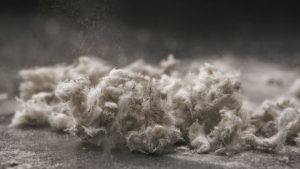So, what is asbestos? Asbestos is a mineral which has been mined extensively and processed for many commercial applications throughout the world. It is commonly known in its various forms as blue asbestos (Crocidolite), brown asbestos (Amosite), or white asbestos (Chrysotile). All types of asbestos are unsafe for humans, and there is no amount of asbestos exposure low enough to be guaranteed 100per cent free of health risk. Lang Hancock, the mining magnate, discovered the deposits and later began pick and shovel mining.
How asbestos gets into the body?
Asbestos fibres can become airborne because they are very fine. Some of them are small enough to get through the smallest airways of the lung to end up in the air sacks where the oxygen gets into the blood. These hook-like fibres can embed themselves in the lungs and remain permanent causing scaring and hardening of the lung tissue; where the spongy parts of the lung become stiffened and shrunken and the air sacks can neither hold as much air as normal nor transfer oxygen across to the body as effectively as usual.
History of asbestos, the wonder mineral
History books tell us this wonder material, asbestos, a mined mineral, had been used in ancient Roma and Greek times as people wove the fireproof, hard wearing fibres into their garments, nets and head coverings. Prior to that, we read of the Finnish peasants using it in their pottery for strength, whilst also sealing cracks in their log huts. It is reported the ancient Egyptians used it in their clothing to improve durability. Emperor Charlemagne, King of the Franks during the medieval times of 700-800 AD, used the fibres in his tablecloths to impress visitors of his supernatural powers as he threw the cloths into the fire and pulled them out unsigned. In fact, for products that come naturally, it would be hard to go past this one – we didn’t! We used it for housing and piping insulation, we made underground and above ground pipes from it, we made roofing, house and factory walls, high temperature seals and gaskets, and it has also gained entry into homes in forms such as ironing blankets, simmering pads for the top of stoves and in talcum powder. We also used it in every brake pad in every vehicle. We imported products made from it and exported the products we made from it. Per capita, we used it more than any other nation in the world.

Asbestos
Changing times
But things have changed recently in the world of asbestos. We now have people dying because of this miracle product. Is has turned sour on us. It has come back to bite us. We have people full of disease due to this wonder mineral. We have heartbroken and destitute families; families robbed of their loved ones and robbed of their future. We have litigation experts suing businesses on behalf of clients, and some companies going into liquidation.
We also had a company and its officers taking assets offshore and making deals and promises that people of integrity could never justify. To Australia, discovering asbestos has taken on a whole new meaning.
